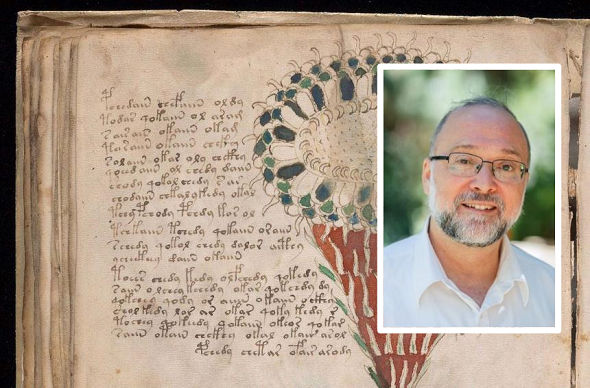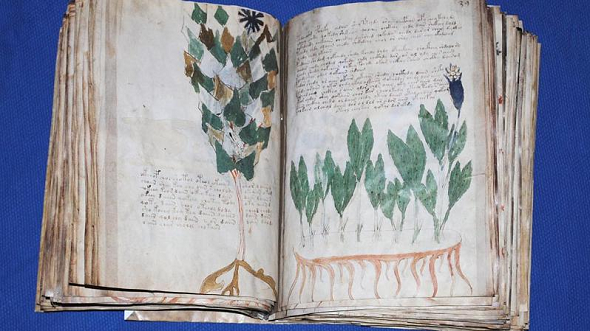German egyptologist Rainer Hannig recently claimed to have solved the Voynich manuscript. Israeli crypto expert Moshe Rubin is skeptical.
A few weeks ago, I reported on a new alleged solution of the Voynich Manuscript, published by German egyptologist Rainer Hannig. Considering that at least 60 Voynich solutions have been published over the last decades, it comes as no surprise that Hannig’s paper didn’t create much excitement.
Like many others before, Hannig doesn’t believe that the text in the Voynich Manuscript was created with an encryption method, but that it was written in a natural language in an unknown script. While others stated that the language in question was Latin, Greek, Armenian, Arabic or something else or a proto-version of one of these, Hannig believes the manuscript is written in Hebrew.
Moshe Rubin
After having published my blog post, I had a short conversation about this new Voynich hypothesis with my Israeli friend George Lasry, who is not only a world-class codebreaker but also speaks Hebrew. George was very skeptical about Hannig’s work, though he hadn’t looked at all the details.
To learn more, he asked Moshe Rubin, another Israeli crypto expert, for his opinion. Moshe is knowledgeable in the field of medieval Jewish liturgical and rabbinic texts.
In fact, Moshe took a closer look at Hannig’s paper and thankfully provided me a comprehensive statement about it. It is reproduced below.
Moshe is a software engineer residing in Jerusalem, Israel. His interest in classical cryptanalysis began at age 15 after reading David Kahn’s classic The Codebreakers from cover to cover multiple times. A reader of Cryptologia since 1977, he tracked down and published the first description of the Chaocipher algorithm, a cipher method that had been secret for decades.
I first heard about Moshe when I wrote my book Codeknacker gegen Codemacher, which covers the Chaocipher in the “Leichen im Krypto-Keller” (“Skeletons in the crypto Cupboard”) chapter.
Moshe told me that he has more research projects on the “back burner” than he can handle – a problem I know very well. He is amazed and grateful for the wonderful publications, websites, conferences, and people giving of their time and energy to further classical cryptanalytic research, and looks forward to contributing to this extraordinary effort.
Moshe’s opinion on Hannig’s solution
Here’s what Moshe wrote me about Hannig’s proposed Voynich solution:
I agree with Klaus that one needs to “ramp up” for each new proposed solution, as there have been so many of them. Having said that, each solution should be appraised based on its ability to decipher the manuscript, nothing else. I have printed out the paper in German and Google-translated to English (I am fluent in Yiddish / Judeo-German, so I don’t see a problem getting through Hannig’s paper).
Without passing any judgment on the proposed solution, I am reminded of David Kahn’s description of Elizabeth Gallup’s “decipherment” of Shakespeare’s works.
I was most interested in section D (“Vollstandige Texte und Textausschnitte” / “Full texts and excerpts”). I first wanted to see if I could duplicate what Hannig says he sees there, assessing the Hebrew / Aramaic he claims to read based on my knowledge of medieval Jewish liturgical and rabbinic texts.
Following that, I wanted to pick a Voynich text of my choosing, and see if I could duplicate Hannig’s results. I worked as “close to the metal” as possible.
In the end, I am entirely unconvinced with the method Hannig uses or with his decipherments. Here are my thoughts:
- The conversion of Voynich symbols to Hebrew letters is inconsistent:
- Occasionally, symbols found in the Voynich text are ignored and not transcribed to Hebrew (e.g., Teˁlᶟ תעה tˁh „irrte“, the “el” sound is ignored).
- At times, a Hebrew letter not in the Voynich is added, ostensibly to turn the transliterated characters into a word (e.g., ‘*jil = jelel’ (“wailing”), and extra ‘j’ was added).
- Some symbols are mapped to one of two very common Hebrew letters (e.g., the same symbol represents both M and N regular and final forms). I can accept that two forms of the S sound (i.e., the letters SAMECH and SIN) are represented by one symbol, but M and N is difficult to accept.
- Hannig’s mapping includes symbols representing “vowels” (i.e., a symbol looking like a lowercase ‘a’, and another resembling a lowercase ‘o’). Hebrew does not have vowels in the Indo-European sense of the word, so it is curious that someone would introduce these characters, making the target word practically unrecognizable. Hannig interprets these vowels inconsistently and at times arbitrarily. As a reader of Hebrew, I struggled to understand how he interpreted the symbols, each time anew.
- The words Hannig extracted are often incredibly archaic forms, rarely, if ever, found in medieval Hebrew texts.
- I refer to the words ‘ginnaḥ’ (“groaned”), ‘ šlh’ (“to be quiet, at ease”), ‘shorba’ (“soup”, in Arabic, not Hebrew), ‘mtim’ (“people”) , ‘*jil = jelel’ (“wailing”), ‘haalayah’ (“raising, lifting”), ‘ha-qam’ (“enemy”), ‘*w-ˁiot’ (“ruins”), and so many more.
- A medieval Hebrew author would certainly have known both Hebrew vocabulary and grammar better than Hannig wants us to believe.
- The overwhelming feeling is that Hannig, having extracted Hebrew letters for a Voynich word, then scoured Hebrew dictionaries for any word, archaic and rare as it may be, for anything that will match or semi-match.
- Anyone who has played the game of Scrabble in Hebrew knows that it is relatively simple to make a word from three random letters (I would say about 30-40%). The probability of Hannig’s extracting 3-4 letters, and then finding a word similar to it, is quite high. I’m not surprised he could make some meaning, as strained as it was, out of the letters.
- And lastly, joining the words together leads to incomprehensible Hebrew.
- Concatenating Hannig’s derived words together makes no sense and strains the imagination to extract meaning from them.
- No educated Hebrew author would have written archaic, ambiguous, and incomprehensible Hebrew, hoping the reader will make sense of the words.
- I would like to believe that, if the underlying language were Hebrew, I would immediately recognize and identify it as such: I’d know it when I see it.
I want to make it perfectly clear: I candidly respect Professor Hannig’s attempt to solve the Voynich, and recognize the enormous effort that went into reaching his conclusions. It is my belief that, as so many other people in so many walks of life, his subjectivity suppressed his objectivity on this topic. I do not believe he has solved the Voynich mystery.
On Sunday morning I received an email from Nick Pelling, a Voynich expert and maintainer of the Cipher Mysteries web site. This was in answer to an email I sent him requesting access to high-quality photos of the manuscript. Here are his words of wisdom to me, perfectly in line with my findings:
“Feel free to knock yourself out looking at Hannig’s theory (which is at least the 10th Voynich-is-Hebrew theory I’ve seen)! If you want to save yourself a load of hassle, look at whichever lines he specifically refers to and take them apart. If it’s like any of the others, it’ll make sense for about 3 words max, before descending into utter, utter meaningless nonsense. But you probably guessed that already.”
When I read this on Sunday morning, it clicked with my findings of the previous night.
I hereby want to thank Moshe very much for writing this extremely helpful statement and for letting me publish it on this blog.
In addition, I want to thank George Lasry for forwarding my questions about Hannig’s paper to Moshe. I consider it now as good as certain that Hannig’s publication is just another unsuccessful try to solve the text in the Voynich Manusript.
Follow @KlausSchmeh
Further reading: Voynich Manuscript: Errrm… no, not really, sorry. But…
Linkedin: https://www.linkedin.com/groups/13501820
Facebook: https://www.facebook.com/groups/763282653806483/





Kommentare (9)